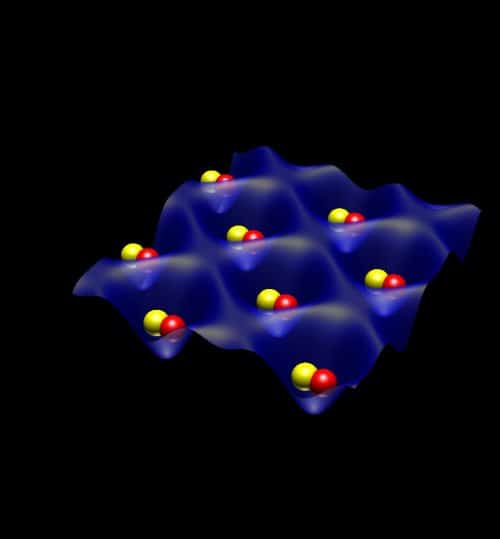Physicists in the US have devised a way to swap the spin states of pairs of ultracold rubidium atoms in an optical lattice. The ability to switch individual spin states back and forth is an important first step towards a "half-SWAP" gate, which is an essential component of a quantum computer (Nature 448 452).

Optical lattices use criss-crossing laser beams to create a matrix of potential wells that can each trap one or more atoms. They are one of several experimental systems that could be used to create practical quantum computers, which exploit the ability of quantum systems to exist in two states at the same time. Rather than use bits, which are either 1 or 0, quantum computers use qubits, which can be in a superposition of both 1 and 0 simultaneously. The idea is that if a quantum computer has N such qubits, these can then be combined or “entangled” to represent 2N values at the same time. By processing each of these values simultaneously, a quantum computer could, in principle, operate exponentially faster than its classical counterpart.
A SWAP gate exchanges the state of two qubits — the spin state of two atoms in an optical lattice, for example. If one atom starts in spin state 1 and the other in 0 (1-0), they end up in 0 and 1 respectively (0-1). What is more interesting to those trying to build quantum computers is the half-SWAP gate, whereby the process is stopped halfway when the state of each individual atom is simultaneously 1 and 0 — and the atoms are entangled. Then, the two atoms could, in principle be physically separated while still entangled.
Now Trey Porto and colleagues at NIST and the University of Maryland in the US, have created at SWAP gate in an optical lattice. They began with two overlapping lattices that were offset slightly in space from one another. In both lattices, each well was occupied by one atom and a radio signal was used to set the spins of all the atoms in one lattice to 1 and all the atoms in the other lattice to 0.
The researchers then carefully adjusted the laser beams to merge the two lattices into one lattice in which two atoms occupy one well. When the two atoms are in the same well, quantum mechanics dictates that the overall quantum state of the two atoms must have a specific symmetry and this restriction causes the system to oscillate between two spin states: 0-1 and 1-0.
By switching off the trapping lasers and applying a magnetic field gradient to the ensemble, the researchers were able to measure the spin state of the atoms at different points in time and confirm that they were oscillating between the two spin states with a period of about 0.4 ms
The team also performed the experiment with both atoms in the same initial states (0-0 and 1-1) and saw no oscillations. Porto told physicsworld.com that this was particularly challenging to achieve because these states are more likely to be destroyed by noise than 0-1 and 1-0.
This is not the first time that a SWAP gate has been demonstrated – in 2005 physicists at Harvard University swapped spin states between electrons confined to two quantum dots. However, the Harvard experiment could only swap 0-1 and 1-0 states, and not 0-0 and 1-1. Although the latter two swaps seem trivial, any practical gate must be able to handle these states.
Porto accepts that the NIST team have also fallen short of performing a complete half swap, because they did not separate the atoms in the entangled state, something that the team are now working on.
Another key challenge facing Porto and others who are trying to build quantum computers based on optical lattices is how to read and write information from individual atoms and manipulate individual wells. This was not done in this experiment — instead the measurements were made on the entire ensemble of atoms and all the wells were controlled in unison.



